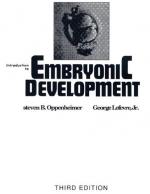|
This section contains 874 words (approx. 3 pages at 300 words per page) |

|
The development of the embryo, or embryogenesis, begins with the repeated divisions of the zygote to give rise to thousands of cells. These in turn form the various tissues and organs of the adult plant. In seed plants, embryogenesis occurs within the embryo sac of the ovule. Since the ovule is transformed into the seed, embryo development is intimately associated with seed formation.
Dicot and Monocot Embryos
The first division of the zygote is almost always asymmetric (uneven) and transverse to its long axis, producing a small apical cell and a large basal (bottom) cell. The apical cell then divides, forming a longitudinal wall, and then divides again, forming a second wall at right angles to the first, to generate a four-celled embryo; subsequent divisions give rise to a globular embryo of eight to thirty-two cells. By changes in shape, accompanied by tissue and organ formation, the globular...
|
This section contains 874 words (approx. 3 pages at 300 words per page) |

|


